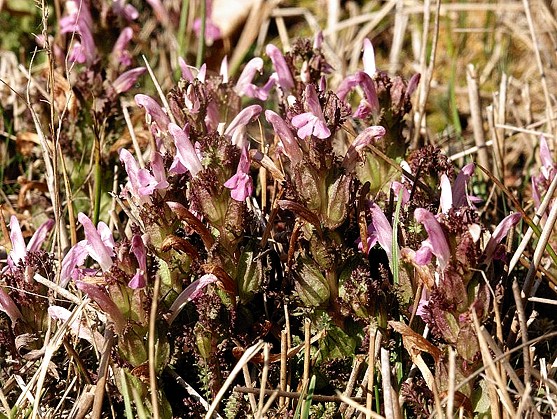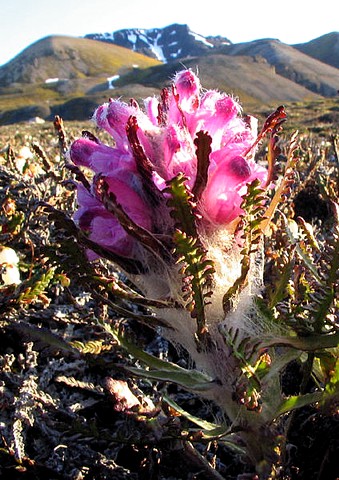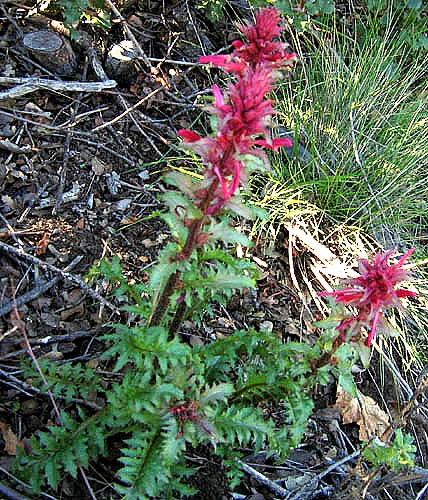Lessico
Pedicolare
Pedicularis

Pedicularis sylvatica
Il nome deriva dall’antica credenza popolare secondo cui le piante
appartenenti a questo genere produrrebbero pidocchi al bestiame che se ne
nutre, essendo il latino pediculus = pidocchio![]() .
.
Il genere Pedicularis della famiglia Scrofulariacee possiede circa 250 specie frequenti nei territori freddi o nelle zone montagnose dell'emisfero settentrionale. Sono erbe alte fino a circa 50 cm, con foglie alterne o verticillate, fiori irregolari, bilabiati, con calice tubuloso o campanulato, raccolti in racemi o in spighe ricche di fiori vistosi, e frutto a capsula. Di solito crescono in terreni umidi e acidi; sono emiparassite e si sviluppano per lo più ai danni di Graminacee. In Italia, nei pascoli e nelle rupi dei monti, crescono spontanee circa 15 specie, tra cui possiamo citare la palustris, la tuberosa, la rostrata e la sylvatica; esse non vengono ben tollerate dal bestiame quando se ne ciba.
Pedicularis recutita
Pedicolare alata. Pianta erbacea perenne, con fusti eretti, glabri, generalmente lucidi, spesso arrossati, semplici, fogliosi. Altezza 20÷50 cm. Le foglie basali pennatosette con segmenti profondamente dentati, le cauline simili, ma progressivamente ridotte. La spiga fiorale, cilindrica e più o meno troncata, è densa di fiori dal calice a tubo con denti brevi, interi e triangolari, la corolla bruno-purpurea è più chiara all’apice e nella parte inferiore, con labbro superiore arrotondato, più grande di quello inferiore, stami emergenti dalla fauce. I frutti sono capsule piriformi. Habitatat: pascoli feschi, sorgenti, rive dei torrenti, vegetazione d’alte erbe (megaforbieto). Endemica delle Alpi ma rara dalla Val d’Aosta alla Carnia.
Pedicularis verticillata
Pedicolare a foglie verticillate. Pianta perenne erbacea, rizomatosa, glabrescente, fusti eretti, semplici, tetragoni con 4 linee di peli, per il resto glabri. Altezza 5÷30 cm. Le foglie inferiori picciolate, pennatosette con segmenti ovali crenati sono riunite in rosetta basale, le cauline quasi sessili, in verticilli di 3-4 simili alle basali, ma pennatofide, anche quelle bratteali sotto l’infiorescenza sono simili, ma minori. L’infiorescenza è formata da una spiga apicale molto densa, conica con brattee arrossate. I fiori, brevemente pedicellati, hanno calice rigonfio, ovoide peloso e violaceo solo nelle nervature con dentelli brevi. La corolla bilabiata, roseo-purpurea, ha labbro superiore arrotondato, l’inferiore brevemente trilobo. I frutti sono capsule ovoidi, sormontate da un becco lungo il doppio del calice. Habitat: prati e pascoli, luoghi rocciosi, 1.500÷2.400 raramente 800÷2.800. Comune in tutto l’arco alpino, più rara nelle Alpi Apuane e nell’Appennino Centrale.
Pedicularis is a genus of perennial green root parasite plants belonging to the broomrape family Scrophulariaceae. Between 350-600 species are accepted by different authorities, mostly from the wetter northern temperate zones, as well as from South America. The highest diversity is in eastern Asia, with 352 species accepted in China alone by the Flora of China The common name lousewort, applied to several species, derives from an old belief that these plants, when ingested, were responsible for lice infestations in stock.
Pedicularis dasyantha

Pedicularis dasyantha (woolly lousewort or arctic hairy lousewort) is a plant native to the high arctic areas of Spitsbergen, Novaya Zemlya and the Jamal Peninsula of Siberia. It grows to 10-15 cm tall, with a stout stem, single or a few together, from a thick, yellow taproot. The basal leaves are numerous and pinnately divided into many remote segments. The stem has many leaves, woolly in the uppermost part between the flowers. The flowers are produced in a dense oblong inflorescence, each flower with a red corolla, with the upper tip hairy; the corolla tube is longer than the calyx. It grows in moist places and on heaths.

Pedicularis groenlandica
Pedicularis groenlandica is a showy flowering plant in the broomrape family which is known by the common names elephant's head and elephanthead lousewort. This erect plant can grow to a height of 80 centimeters. Its sharply-toothed fernlike leaves are located low on the stout stem. The stem is topped with a large inflorescence of bright pink to purple or white flowers. Each flower has a long, pointed beak which curves upward, superficially resembling the trunk of an elephant, and the lateral lobes of the flower resemble an elephant's ears. Like other louseworts and related broomrape genera, this is a root parasite which obtains nutrients from the roots of other plants by piercing them with haustoria. This plant is found in the high mountain ranges of western North America, particularly the Cascades and High Sierra. It grows in wet environments such as riverbanks. The dried flowers of this plant when smoked produce a high very similar in effect to marijuana without the anxiety or paranoia effects.
Pedicularis densiflora

Pedicularis densiflora, known commonly as Indian warrior, is a plant of the lousewort genus in the broomrape family. It is a perennial herb with stout, green or sometimes reddish or magenta stems and fern-shaped leaves, and long spikes of deep red to bright pink flowers with toothed petals. Like others of its genus, it is a root parasite, attaching to the roots of other plants to obtain nutrients and water. This species is a facultative parasite, or hemiparasite, in that it can live without attaching to another plant but will parasitize if presented with the opportunity. It often parasitizes plants of the heath family, such as manzanita. Indian warrior is native to western North America and is found in forests and woodlands at low elevation. The buds of Indian warrior are sold as medicinal herbs and are smoked for their psychoactive effects. These effects include muscle relaxation, tranquilization, and sedation.
Pedicularis foliosa